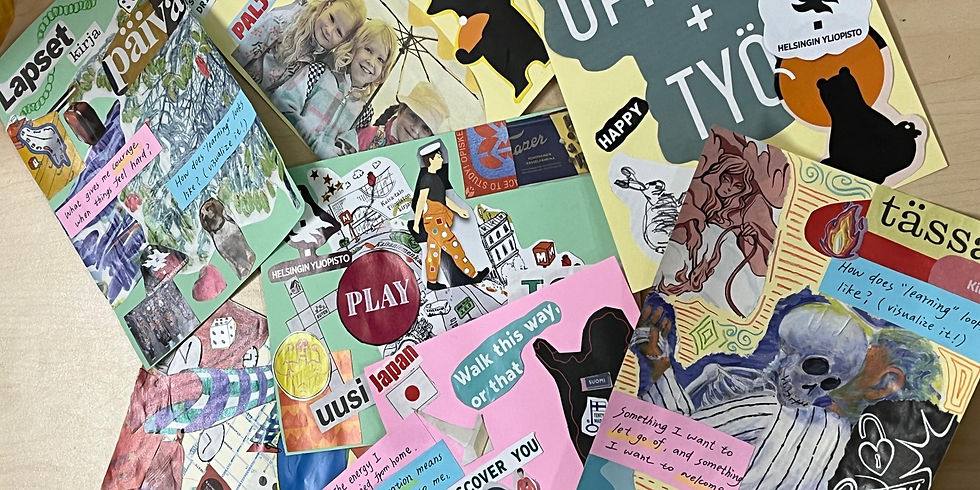5 Questions About Music Therapy Answered by Neuroscience Research
- Alicia Lucendo Noriega

- Apr 9, 2021
- 7 min read
Updated: Apr 25, 2021
Have you ever heard the term “music therapy” but are still not 100% sure what this term actually means? Well, the World Federation of Music Therapy (WFMT) defines it as:
“Music therapy is the professional use of music and its elements as an intervention in medical, educational, and everyday environments with individuals, groups, families, or communities who seek to optimize their quality of life and improve their physical, social, communicative, emotional, intellectual, and spiritual health and wellbeing. Research, practice, education, and clinical training in music therapy are based on professional standards according to cultural, social, and political contexts” (WFMT, 2011).
But yes, I get it… even after reading this very detailed definition, there are still many questions unanswered. Well, this blog post is for you! In this case, it will not just be me (a hopefully soon qualified music therapist) answering all these questions. Instead, neuroscience research in the field will take the role for now! Sounds promising, right?
So, if you’d like to learn more about this fascinating field, keep reading!
Hold on… how is music therapy connected to neuroscience?!
Even if you don’t believe it yet, these two fields are connected. Did you know that there is indeed a term referring to this “neurologic music therapy”? There are already many studies that have researched the neurologic benefits of music therapy in different situations. Recent studies have found that music intervention leads to normalisation of resting-state brain functional connectivity and improvement in social communication in children with autism spectrum disorder (ASD). Similarly, music therapy was found to improve executive functions and normalise resting-state brain functional connectivity in patients with traumatic brain injury. Besides this, another important focus has been proving how to connect music therapy with different neuroscientific methods. For example, functional magnetic resonance imaging (fMRI) was used to test the feasibility of Creative Music Therapy, electroencephalography (EEG) was used to study how music therapy can modulate brain activity and reduce anxiety in patients with depression, and magnetencephalography (MEG) was used to analyse different brain responses to pain during various music therapy approaches. So, as O’Kelly and colleagues explain in their 2016 article, while neuroscience reveals more evidence of the efficacy of the intervention, music therapy allows to learn more about the neural effects in more real-life clinical contexts! As you see, it can really be a win-win situation!
So then, who is music therapy for?
This music therapy topic is now really intriguing you, isn’t it? Well, to put it simply: Music therapy is for everyone! There are studies in every age group starting from preterm infants! Findings show that Creative Music Therapy can have benefits on preterm babies’ brain activity and connectivity which might improve further neurodevelopmental outcomes. Infants’ mothers could also benefit from singing in kangaroo care, because it seems to decrease maternal anxiety levels and support the relationship with the baby. Moving to older groups of children, such as patients diagnosed with ASD, and all the way to older people for neurological rehabilitation or aiding patients with traumatic brain injury.
But in practice, is music therapy just listening to music?
Absolutely not! There are several models of music therapy that are based on different music approaches as well as various contexts (hospital, social, education…) Although many focus on listening to music, which corresponds to passive music therapy (ex: “Guided Imagery and Music” - GIM), other interventions move towards more active approaches, such as by playing instruments, singing, or improvising. For example, one study that researched the effects of active music therapy using fMRI found significant activation of certain brain areas associated with autobiographical and memory processes. Another study analysed benefits on preterm babies by adopting the Creative Music Therapy model (i.e., Nordoff-Robbins), which is based on improvisation and lullabies that are continuously adapted according to the infant’s needs.
So, do I need to know music before the intervention?
If you are the patient, not necessarily! In one study with patients with traumatic brain injury, the intervention did not require prior music experience and still there were some benefits found on everyday behavioural regulation skills. HOWEVER, if you are the one providing the therapy (i.e., the music therapist), it is a whole different story. For that, you will not only need musical knowledge, but also training in other areas such as in psychology, and the official qualification is acquired through higher education programs. Indeed, we cannot forget about the second word: THERAPY. This means that music therapy goes way beyond just music (whether it means listening to it or playing an instrument) and acknowledges features such as the relationship between the therapist-client as key elements. Did you know that dialogue and talking about feelings / thoughts that a client experienced during the session is usually common to most of the models? In fact, the objectives set for the intervention are therapeutic according to the patient’s needs, not related to musical skills.
Ok, everything seems perfect, so where is the “but”?
You guessed it right… as with everything in life, music therapy is far from being perfect. There are definitely some issues that often arise in research. For example, in the neuroscience field, how could we take into account the more creative, improvisational and spontaneous situations that usually arise in music therapy sessions? Additionally, as O’Kelly and co-authors write, how can these neurological findings improve the field of music therapy?. Besides this, there is still some confusion between the distinction of music therapy and music medicine (which for example does not rely on the therapist-client relationship ), or among the knowledge and skills needed for the music therapist. Moreover, apart from acknowledging the advantages, it is equally important to realize that not all studies found concluding evidence of music therapy benefits. So yes, there is an important need of more research to clarify the evidence of different models and interventions. But even then, it is undeniable that music therapy provides many promising benefits in different situations! So, doesn’t this make it more appealing to conduct further research and discover this field more in depth? For education, doesn’t it seem like music therapy could be a successful answer to many students’ needs?Hence, how can we promote more research to fully take advantage of this promising field? By achieving this, we will also find what music therapy can provide in bringing the change in education!
References
Altenmüller, E., & Schlaug, G. (2013). Neurologic music therapy: the beneficial effects of music making on neurorehabilitation. Acoustical Science and Technology, 34(1), 5-12.
Bieleninik, L., Geretsegger, M., Mössler, K., Assmus, J., Thompson, G., Gattino, G., Elefant, C., Gottfried, T., Igliozzi, R., Muratori, F., Suvini, F., Kim, J., Crawford, M. J., Odell-Miller, H., Oldfield, A., Casey, Ó., Finnemann, J., Carpente, J., Park, A.-L., … for the TIME-A Study Team. (2017). Effects of Improvisational Music Therapy vs Enhanced Standard Care on Symptom Severity Among Children With Autism Spectrum Disorder: The TIME-A Randomized Clinical Trial. JAMA, 318(6), 525. https://doi.org/10.1001/jama.2017.9478
Fachner, J., Gold, C., and Erkkila, J. (2013). Music therapy modulates frontotemporal activity in rest-EEG in depressed clients. Brain Topogr. 26, 338–354. doi:10.1007/s10548-012-0254-x
Haslbeck, F. B., & Bassler, D. (2018). Music from the very beginning—a neuroscience-based framework for music as therapy for preterm infants and their parents. Frontiers in Behavioral Neuroscience, 12, 112.
Haslbeck, F. B., Jakab, A., Held, U., Bassler, D., Bucher, H. U., & Hagmann, C. (2020). Creative music therapy to promote brain function and brain structure in preterm infants: A randomized controlled pilot study. NeuroImage: Clinical, 25, 102171.
Hauck, M., Metzner, S., Rohlffs, F., Lorenz, J., & Engel, A. K. (2013). The influence of music and music therapy on pain-induced neuronal oscillations measured by magnetencephalography. PAIN, 154(4), 539–547. https://doi.org/10.1016/j.pain.2012.12.016
Hunt, A. M. (2015). Boundaries and potentials of traditional and alternative neuroscience research methods in music therapy research. Frontiers in Human Neuroscience, 9. https://doi.org/10.3389/fnhum.2015.00342
Koelsch, S. (2009). A Neuroscientific Perspective on Music Therapy. Annals of the New York Academy of Sciences, 1169(1), 374–384. https://doi.org/10.1111/j.1749-6632.2009.04592.x
Kostilainen, K., Mikkola, K., Erkkilä, J., & Huotilainen, M. (2020). Effects of maternal singing during kangaroo care on maternal anxiety, wellbeing, and mother-infant relationship after preterm birth: a mixed methods study. Nordic Journal of Music Therapy, 1-20.
Magee, W. L., & Stewart, L. (2015). The challenges and benefits of a genuine partnership between music therapy and neuroscience: a dialog between scientist and therapist. Frontiers in Human Neuroscience, 9, 223.
Martinez-Molina, N., Siponkoski, S. T., Kuusela, L., Laitinen, S., Holma, M., Ahlfors, M., Jordan-Kilkki, Päivi., Ala-Kauhaluoma, K., Melkas, S., Pekkola, J., Rodriguez-Fornells, A., Laine, M., Ylinen, A., Rantanen, P., Koskinen, S., Cowley, B.U., & Särkämö, T. (2020). Resting-state network plasticity induced by music therapy after traumatic brain injury. medRxiv.
O’Kelly, J., Fachner, J. C., & Tervaniemi, M. (2016). Editorial: Dialogues in Music Therapy and Music Neuroscience: Collaborative Understanding Driving Clinical Advances. Frontiers in Human Neuroscience, 10. https://doi.org/10.3389/fnhum.2016.00585
Raglio, A., Galandra, C., Sibilla, L., Esposito, F., Gaeta, F., Di Salle, F., Moro, L., Carne, I., Bastianello, S., Baldi, M., & Imbriani, M. (2016). Effects of active music therapy on the normal brain: FMRI based evidence. Brain Imaging and Behavior, 10(1), 182–186. https://doi.org/10.1007/s11682-015-9380-x
Särkämö, T., Altenmüller, E., Rodríguez-Fornells, A., & Peretz, I. (2016). Music, brain, and rehabilitation: emerging therapeutic applications and potential neural mechanisms. Frontiers in human neuroscience, 10, 103.
Sharda, M., Tuerk, C., Chowdhury, R., Jamey, K., Foster, N., Custo-Blanch, M., Tan, M., Nadig, A., & Hyde, K. (2018a). Music improves social communication and brain connectivity outcomes in children with autism: A randomized controlled trial [Preprint]. PsyArXiv. https://doi.org/10.31234/osf.io/2xnmv
Siponkoski, S-T, Koskinen S., Laitinen S., Holma, M., Ahlfors, M., Jordan-Kilkki, P., Ala-Kauhaluoma, K., Martinez-Molina, N., Melkas, S., Laine, M., Ylinen, A., Zasler, N., Rantanen, P., Lipsanen, J. and Särkämö, T. (2020). Effects of neurological music therapy on behavioral and emotional recovery after traumatic brain injury: a randomized controlled cross-over trial. Neuropsychological Rehabilitation (in press).
World Federation of Music Therapy (WFMT, 2011). What is music therapy?https://www.wfmt.info//wp-content/uploads/2014/05/ENGLISH-NEW-What-is-music-therapy.pdf
About Alicia

Hi, I am Alicia Lucendo Noriega, a primary education teacher and (hopefully soon) qualified music therapist studying for the MA in Changing Education. I am passionate about music and education and learning more about how to connect these fields to change education!




Comments